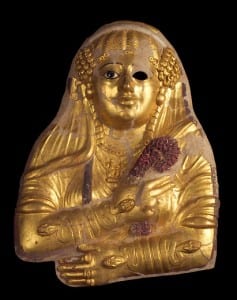Egypt on the Stage: A Tale of two Queens
By Edmund Connolly, on 20 April 2014
Egypt has had many theatrical incarnations, one of the most famous, and my favourite, being Shakespeare’s epic The Tragedy of Anthony and Cleopatra, which forged a time defying reflection of Cleopatra Philopator, and Queen Elizabeth I, the Virgin Queen.
Most probably written around 1606 this play can be studied in conjunction with the preceding Macbeth as a play about monarchy, rulership and conquest. The two protagonists (Cleo. and Mac.) could be compared as a good and bad example of monarch; I like to think Cleopatra is definitely the paragon.
A Pair of Queens
Perhaps second only to Tutankhamun in the who’s-who of Ancient Egypt Cleopatra VII is colloquially known as the Last Queen of Egypt. This is a very debatable epithet, whilst she is the last pharaoh of Egypt, she is also the last of Ptolemaic dynasty, a Greek family who ruled Egypt following Alexander’s conquest in 332 BC. Her death, 12th August 30 BC, is chronicled by Plutarch, mentioned by Virgil and exonerated by Horace[1], she is so renowned her death is sometimes used to denote the end of the Hellenistic era.

Queen Elizabeth depicting herself with Classical Gods, like Cleopatra and her Isis costumes.
Queen Elizabeth I and Goddesses, attrib: I. Oliver, 1590. copyright National Portrait Gallery
Queen Elizabeth, who died 3 years prior to this play’s performance, is quite a similar character. With a slightly dubious claim to the throne, her death in 1603 heralded the end of the Tudor rule. Following the establishment of the Church of England in the 1530’s and the sweeping massacres of Catholics and Protestants alike England had a Catholic Scottish King, James I. For years England had been at war with both Scots and Catholics, and now had that exact ilk on their throne.
Cleopatra faced similar regency problems; she may have been an originally Greek Queen, but she was barring the advancing Roman Empire from Romanising her country and herself. Here the Queens differ, Elizabeth went on the offence, striking out at Catholic enemies, such as Spain with her famous victory in 1588. Cleopatra had nowhere near the allies nor resources to defeat her foe (indeed she lost her major naval incursion at Actium), so she had to make them.
Allying herself to Caesar and then Mark Anthony she coerced armies and treaties out of them to protect her beloved Egypt. Plutarch, writing in the 1st century AD, describes Mark and Cleopatra’s first encounter as:
“Venus was come to revel with Bacchus for the good of Asia” (Lives III.XXVI.3)
Cleopatra is represented as the Roman goddess of love and founder of Rome, great praise for an Egyptian Queen who defied them.
Queens at War

a terracotta perhaps of Cleopatra II or III in a traditional Hellenic costume. UC47952. Petrie Museum of Egyptian Archaeology
Elizabeth I adopted the character of Gloriana when she gave her rousing speech prior to the English victory against the imposing Spanish foe in 1588. Centuries later this character inspired Benjamin Britain to write his three act opera The Faerie Queene in 1928. Perhaps Shakespeare was using the character of Cleopatra as an homage to James’ precursor. Cleopatra’s hold over Anthony was so strong he is described as “an appendage of the woman” (Plut. Lives DXII.2).
Queens of Death
Cleopatra epitomises a facet of rulership Shakespeare clearly exonerates[2], and that is duty. Facing impossible odds she takes her own life, which, perhaps paradoxically, is a cause for reverence. Again, drawing on Plutarch but echoed by Shakespeare, Horace and Elizabeth Taylor in her 60’s rendition, it is clear her choice of death and refusal to be subjugated helped immortalise her:
” [Caeser to Charmion, Cleopatra’s maid] ‘A fine deed, this, Charmion’
‘It is indeed most fine’, she said, ‘and befitting the descendant of so many kings’ “.
(Lives IICV.3)

A Roman cartonnage mask, with the female wearing snake bracelet, perhaps an homage to Cleopatra? UC28084. Petrie Museum of Egyptian Archaeology
Elizabeth may not have had the romantic death of her Egyptian counterpart, but she certainly faced death in her own life. Her mother was beheaded at her Father’s hands when she was three year old and she had lived to see her sibling monarchs, Edward and Mary, instigate years of killing and persecution of supposed traitors and ‘opposers’ to the throne.
Not only are Cleopatra’s armies massacred, but her lover Anthony dies at his own hands, and his son is killed by his own tutor (Plut. Lives. IIDI.1) Both Queens reflect a time of national unrest and war, and both were looked to to prevent further bloodshed. Cleopatra chose to end her own life rather than cessate Egypt, whilst Elizabeth fought until the bitter end, securing her beloved England.
I would not for one moment suggest Cleopatra’s rule was a failure; following her death statues of Mark Anthony, a traitor to his own Rome, were defiled and destroyed, whilst Cleopatra’s remained unharmed and left as a monument to the great Queen (Plut. Lives IICVI.5). The Egyptian Queen on Shakespeare’s stage faces her own apotheosis, realising “I [Cleopatra} have nothing/ Of woman in me. Now from head to foot I am marble-constant. Now the fleeting moon / No planet is of mine.” (V.2).
[1] From which these immortal stanzas come:
And she dared to gaze at her fallen kingdom
with a calm face, and touch the poisonous asps
with courage, so that she might drink down
their dark venom, to the depths of her heart,
growing fiercer still, and resolving to die:
scorning to be taken by hostile galleys,
and, no ordinary woman, yet queen
no longer, be led along in proud triumph. (Horace. Odes I.37)
[2] One only has to read King Lear to see what he thinks of Kings who abdicate
One Response to “Egypt on the Stage: A Tale of two Queens”
- 1
 Close
Close




thanks for info